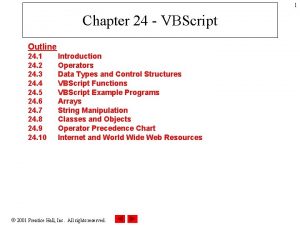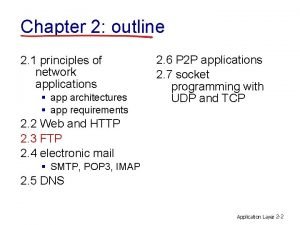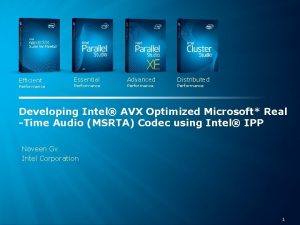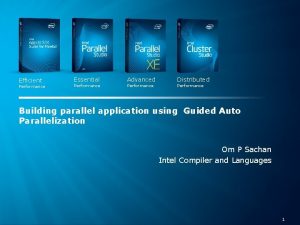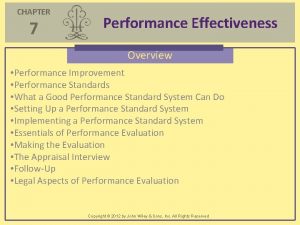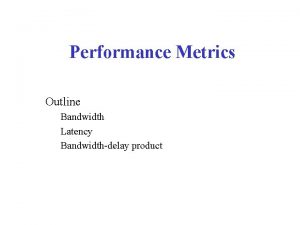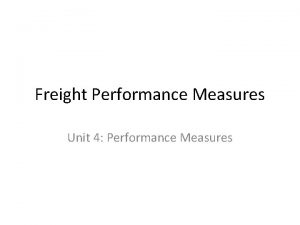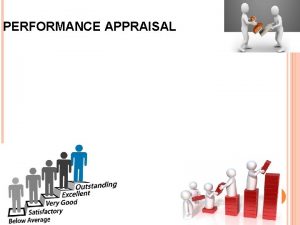Chapter 8 Performance Chapter Outline What is Performance



















- Slides: 19

Chapter 8 Performance

Chapter Outline • What is Performance? • Performance General Scenario • Tactics for Performance • A Design Checklist for Performance • Summary

What is Performance? • Performance is about time and the software system’s ability to meet timing requirements. • When events occur – interrupts, messages, requests from users or other systems, or clock events marking the passage of time – the system, or some element of the system, must respond to them in time. • Characterizing the events that can occur (and when they can occur) and the system or element’s time-based response to those events is the essence is discussing performance.

Performance General Scenario

Sample Concrete Performance Scenario �Users initiate transactions under normal operations. The system processes the transactions with an average latency of two seconds.

Goal of Performance Tactics • Tactics to control Performance have as their goal to generate a response to an event arriving at the system within some time-based constraint.

Goal of Performance Tactics

Performance Tactics

Control Resource Demand • Manage Sampling Rate: If it is possible to reduce the sampling frequency at which a stream of data is captured, then demand can be reduced, typically with some loss of fidelity. • Limit Event Response: process events only up to a set maximum rate, thereby ensuring more predictable processing when the events are actually processed. • Prioritize Events: If not all events are equally important, you can impose a priority scheme that ranks events according to how important it is to service them.

Control Resource Demand • Reduce Overhead: The use of intermediaries (important for modifiability) increases the resources consumed in processing an event stream; removing them improves latency. • Bound Execution Times: Place a limit on how much execution time is used to respond to an event. • Increase Resource Efficiency: Improving the algorithms used in critical areas will decrease latency.

Manage Resources • Increase Resources: Faster processors, additional memory, and faster networks all have the potential for reducing latency. • Increase Concurrency: If requests can be processed in parallel, the blocked time can be reduced. Concurrency can be introduced by processing different streams of events on different threads or by creating additional threads to process different sets of activities. • Maintain Multiple Copies of Computations: The purpose of replicas is to reduce the contention that would occur if all computations took place on a single server.

Manage Resources • Maintain Multiple Copies of Data: keeping copies of data (possibly one a subset of the other) on storage with different access speeds. • Bound Queue Sizes: control the maximum number of queued arrivals and consequently the resources used to process the arrivals. • Schedule Resources: When there is contention for a resource, the resource must be scheduled.

Design Checklist for Performance

Design Checklist for Performance

Design Checklist for Performance

Design Checklist for Performance

Design Checklist for Performance

Design Checklist for Performance

Design Checklist for Performance
 Quotation sandwiches
Quotation sandwiches Behaviorally anchored rating scales
Behaviorally anchored rating scales Behaviorally anchored rating scales
Behaviorally anchored rating scales Jcids process
Jcids process Labeling theory examples
Labeling theory examples Romans outline by chapter
Romans outline by chapter Component of research proposal
Component of research proposal Foner chapter 27
Foner chapter 27 Secondary data
Secondary data Chapter 38 a world without borders outline
Chapter 38 a world without borders outline Vbscript
Vbscript The hunger games chapter 23 summary
The hunger games chapter 23 summary Chapter 31 societies at crossroads
Chapter 31 societies at crossroads Ap world history chapter 28 outline
Ap world history chapter 28 outline Chapter 2 learning goals outline sociology answers
Chapter 2 learning goals outline sociology answers Chapter 1 outline
Chapter 1 outline Chapter 1 outline
Chapter 1 outline Chapter 30
Chapter 30 Chapter 2 outline
Chapter 2 outline Outline of acts
Outline of acts










